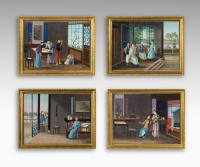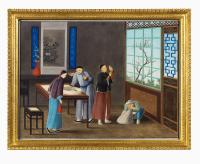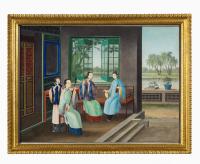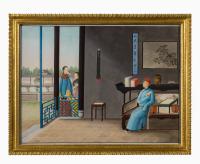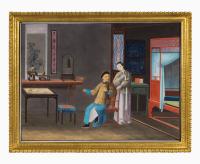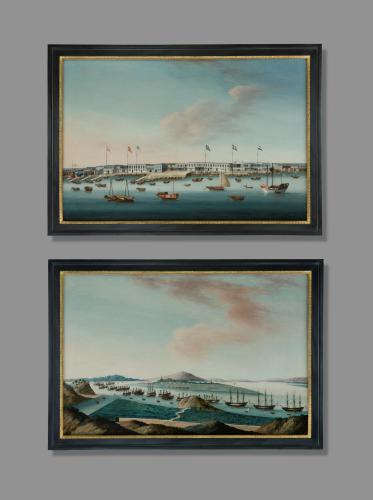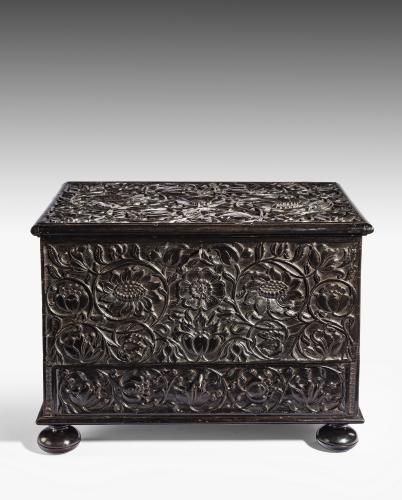
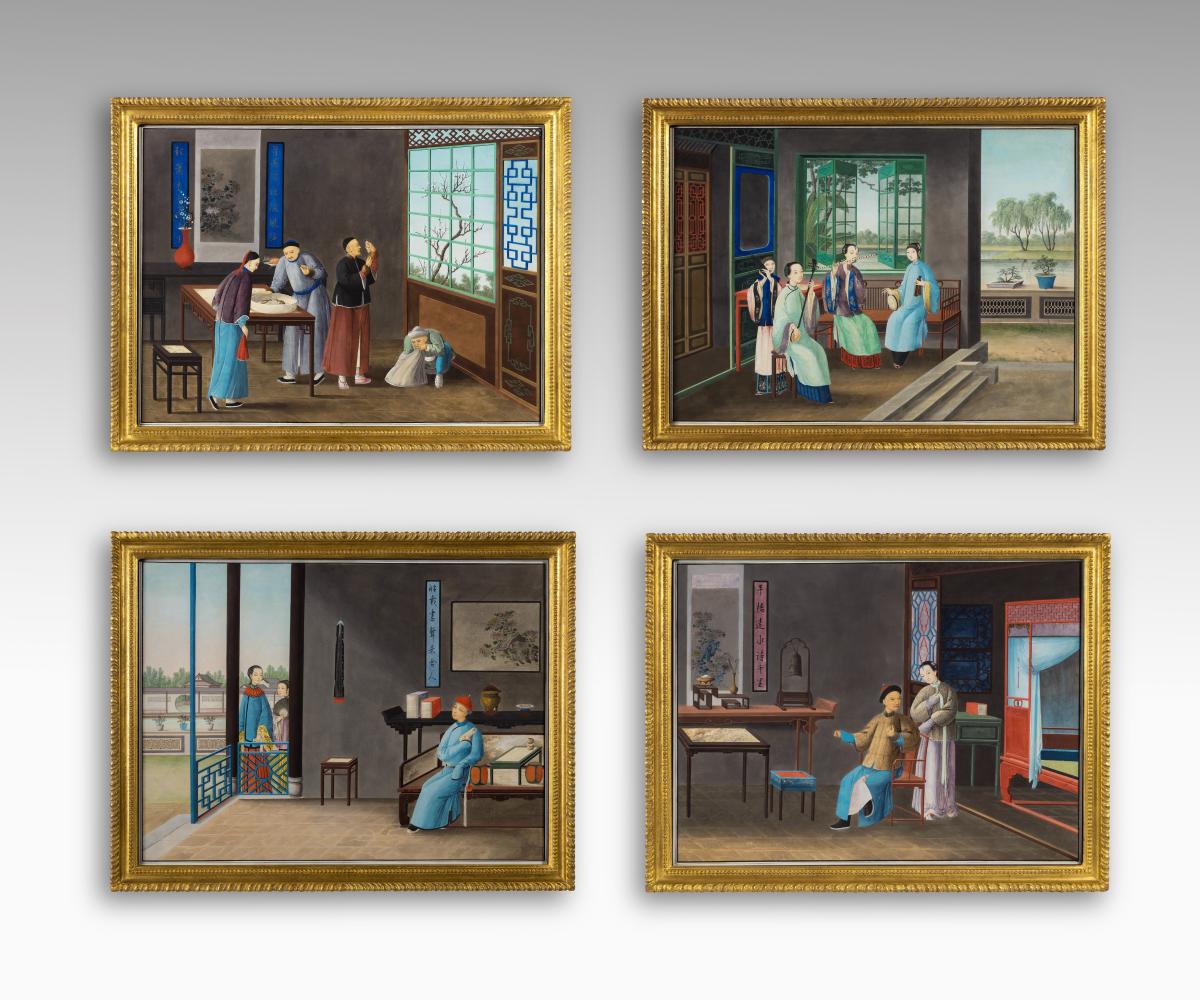
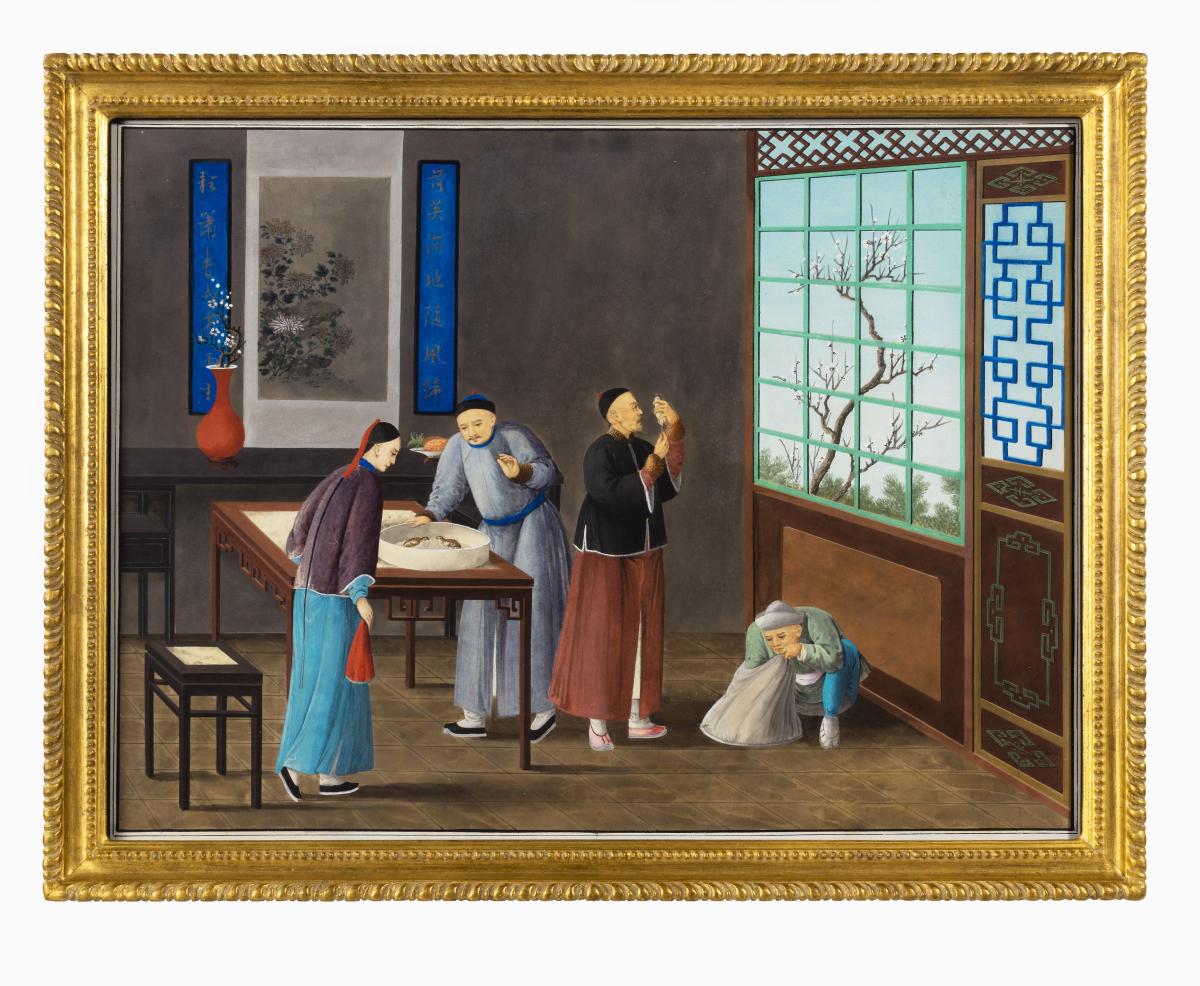
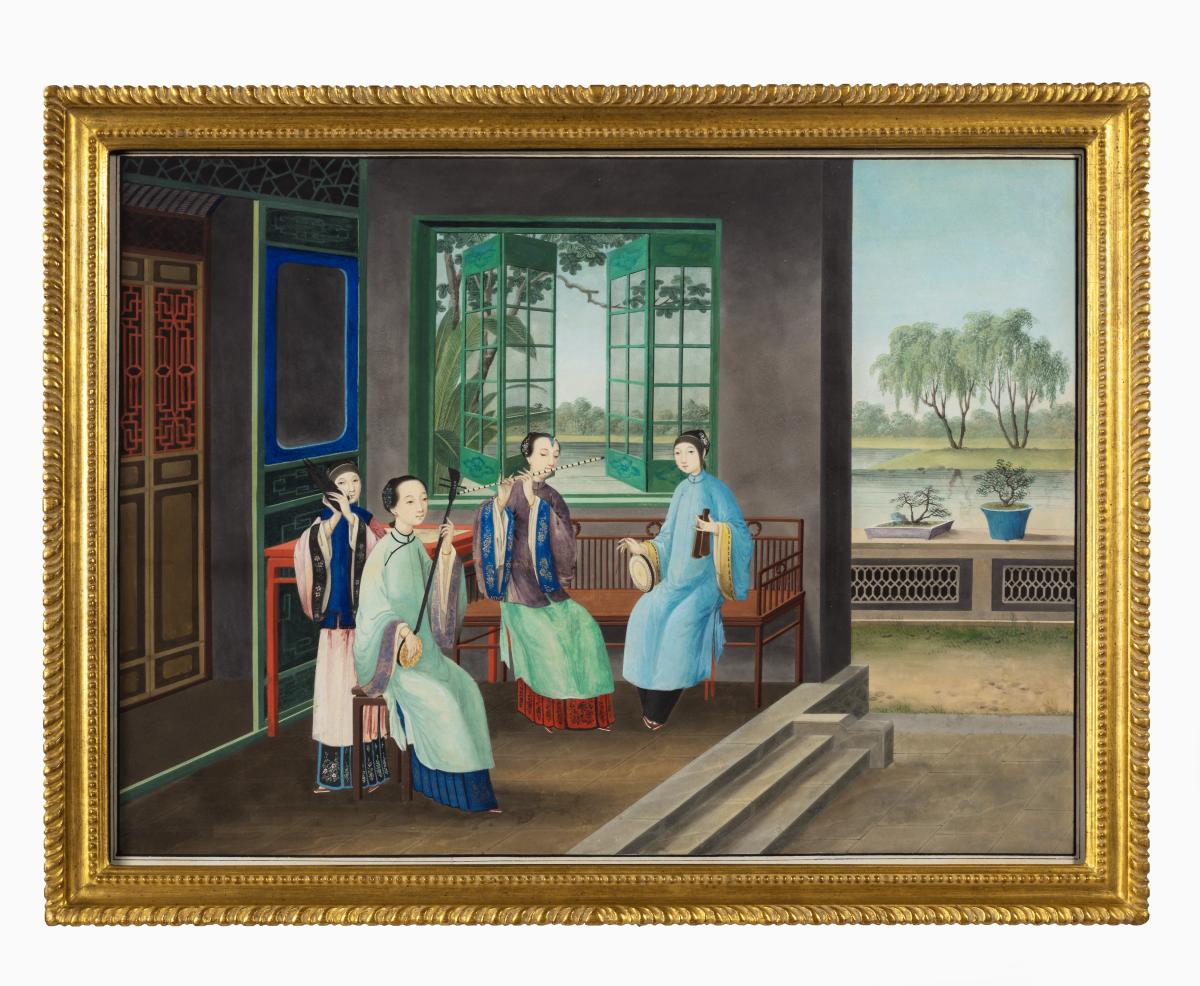
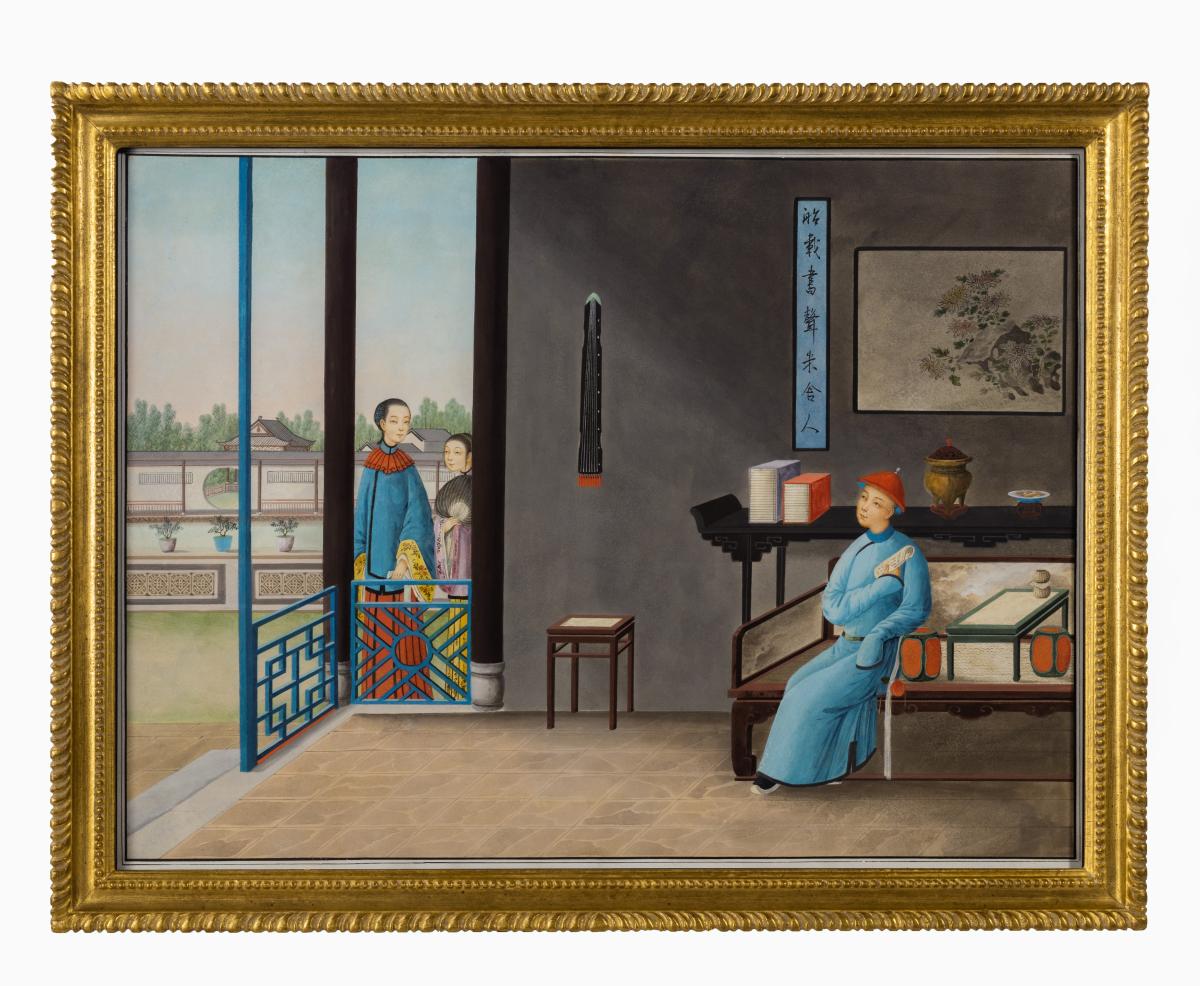
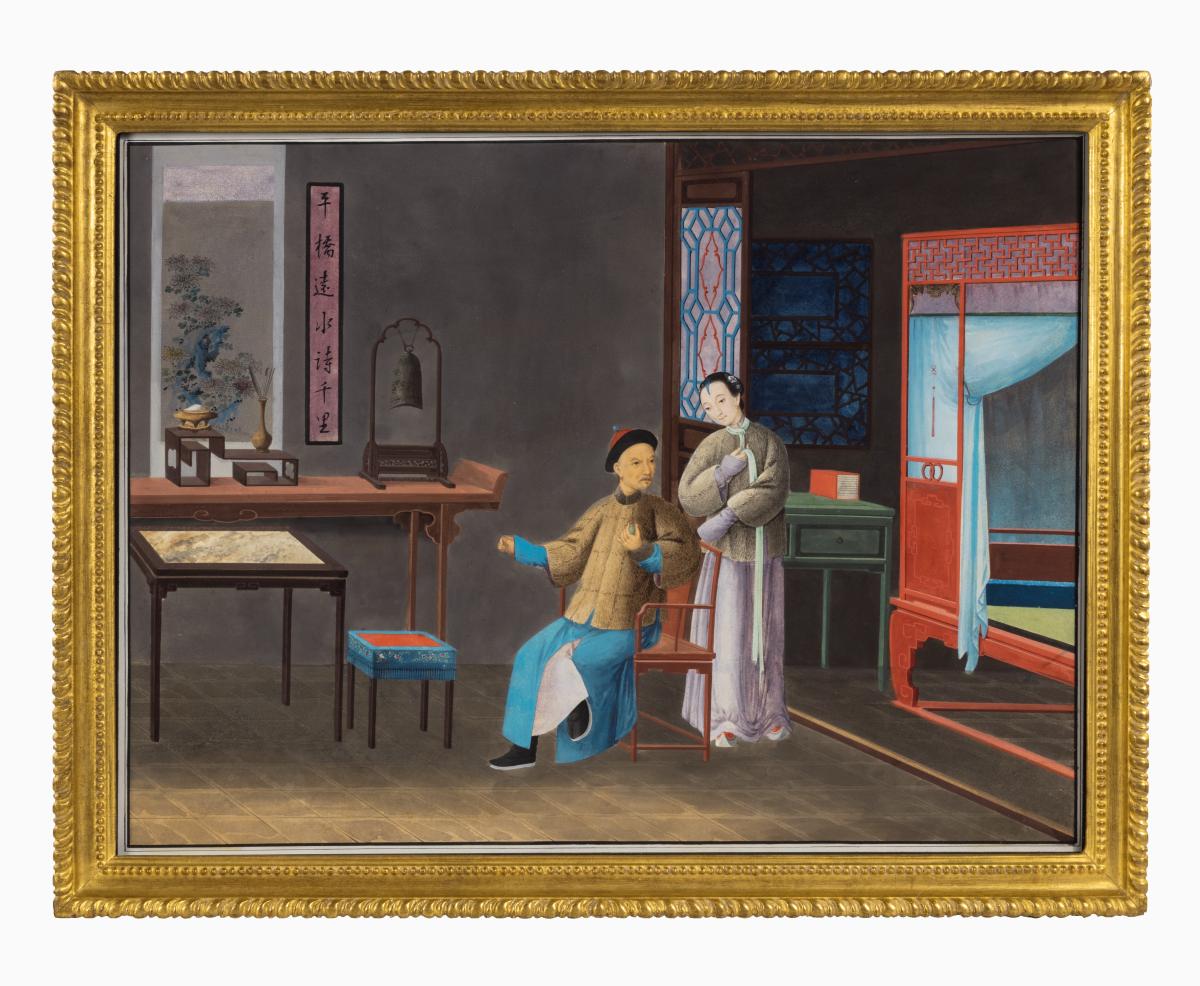
This object is eligible for a Certificate of BADA Provenance
The BADA Standard
- Since 1918, BADA has been the leading association for the antiques and fine art trade
- Members are elected for their knowledge, integrity and quality of stock
- Our clients are protected by BADA’s code of conduct
- Our dealers’ membership is reviewed and renewed annually
- Bada.org is a non-profit site: clients deal directly with members and they pay no hidden fees
Set of four Qing Dynasty Chinese Export Paintings of Interiors.
CHINA, EARLY 19TH CENTURY.
Gouache on paper.
A set of four framed Chinese paintings in gouache on paper depicting a group of four female musicians; a gentleman seated beside a lady, a snuff bottle in hand; a group of men with their quails; and a young man seated and holding a scroll looking at one of two maidens outside in the garden. Each of the settings has fine furnishings and paintings and shows well-tended gardens.
A detailed explanation of the scene in each of the paintings follows. We are grateful to Yixin Xu for her work on cataloguing these works.
Image lower left: The furnishings in the painting reflect the typical taste for interior decoration of the well-educated and rich families of the Ming (1368-1644) and Qing (1644-1911) dynasties. In this painting, a young scholar with a book in his hand is seated on a Louhan couch. Louhan couches (literally means arhat couches) are low seats that originated in the Han dynasty and were mainly placed in living rooms or studies to host guests in the Ming and Qing dynasties. This Louhan couch, decorated with cloud motifs, is covered with woven mats and surrounded by marble-inlaid panels, echoing the wooden stool, also inlaid with marble, a short distance away. On top of the Luohan couch is a low kang table and two garden stool-shaped cushions prepared to serve the guests.
If the fine furniture hints at the young man's wealthy family, the decorative objects in the picture reveal his exceptional artistic tastes. On the wall hangs the second half of the couplet:
詩傳畫意王摩詰, 船載書聲米舍人
His poem conveys the charm of paintings, speaking of Wang Mojie (Tang Poet, 699-759)
His boat carries the sound of reading, speaking of Mr. Mi.
Mi Fu (1051-1107) was a famous Northern Song (960-1127) painter, calligrapher and poet who also had a passion for collecting stones. The couplet came from a poem by the Ming poet Shen Ying but was first used in a study by Wu Guoxiang (1755-1795), a Qing scholar. In between the two parts of couplet is a painting of chrysanthemums.
Chrysanthemums are a symbol of integrity and nobility in Chinese culture, thus subtly conveying the noble character of the owner of the study. On the left of the couplet hangs a guqin, a seven-stringed musical instrument that was often associated with a scholar's self-cultivation. In ancient China, it was a common social expectation for young men to study hard and become an official through the imperial examinations, which may explain why the woman in the picture is looking at the young man with great expectation.
On a table against the wall are books, an incense burner and a fruit bowl. Interestingly, the fruits in the plate are called ‘Buddha’s hand’ citrus or xiangyuan. According to Wu Fangsi, ‘they derive their name from the tapered, finger-like forms, and the association with the revered figure of Buddha is auspicious. The word for “hand” and “longevity “have the same sound in Chinese, so Buddha hands are doubly auspicious. They appear frequently in paintings and were used to scent rooms and clothes.’ Such fruits are mainly grown in the Southern China, including Guangdong.
Image lower right: This painting presents us with the furnishings of a bedroom, an intimate space in the home of a rich Chinese family. In the center of the scene, a gentleman is sitting relaxed in a chair, holding a snuff bottle in his left hand, and turning back to talk to the woman behind him (possibly his wife or concubine). The fur-textured blouse on the two reveals their wealthy status. Behind them is a typical Qing canopy bed with inner angles carved in the shape of bats. The Chinese character for bat, Fu, has an auspicious meaning due to its homonymy with the Chinese character for good fortune, ‘Fu’, in traditional Chinese culture, making it a common animal decoration in Chinese furniture.
Even in a relatively private sphere, items that reflect the owner's refined taste are indispensable. On the table is a geometric miniature curio display stand. Such stands were often used to display small curiosities and were particularly popular in the Qing Dynasty. On the shelf is a vase and an incense burner. In the Chinese literati tradition, the vase, along with the incense burner, and a box to hold the incense are known as the “three necessaries for incense,” and having a set of incense utensils became fashionable for the literati. To the right of the display stand, an antiqued bronze musical bell hangs on a wooden shelf. Displaying such antiqued bells was also quite common at the time - sometimes people would strike the bell to enjoy its melodious sound. The couplet hanging on the wall next to the painting depicting chrysanthemums was written by a local Guangdong scholar, Chen Mengchi. Only the first half of the couplet appears in the painting: "Water flows far away under the flat bridge, poetry stretches for a thousand miles", while the second half of the couplet should read: "Flowers are in full bloom on the lush trees, moonlight fills a curtain". (平橋遠水詩千里;錦樹濃花月一簾)
It is worth mentioning that the red textiles covering the chairs in the picture add a touch of delicacy to the room. This embroidered chair cover was usually made by the women of the family.
Andrew Lo, Song Jiayu, Wang Tzi-Cheng, Frances Wood, Chinese Export Paintings of the Qing Period in the British Library Volume Ⅳ, Guangzhou: Guangzhou Provincial Publishing House, 2011. p13, p.71.
Image upper right: The painting depicts four female musicians playing operas on the stage. From left to right, the musical instruments that musicians are playing are sheng (a Chinese mouth-blown reed instrument consisting of vertical pipes), sanxian (a three-stringed traditional Chinese lute with a resonator traditionally made from snakeskin - as can be seen from the painting), di (a Chinese flute) shuban and diangu (typical Chinese clappers and drums used to play rhythm while singing. Among them, the musicians who play sanxian and percussion instruments can play their instruments and sing at the same time and are therefore the central characters of the performance.
In the 19th century in Guangdong, opera performances were already very popular among the people. At the time, many wealthy Cantonese merchants had such semi-open buildings in their homes to enjoy the natural beauty of their gardens while appreciating music. Sometimes they invite female musicians to perform Chinese operas, especially to entertain foreign guests.
Image upper left: depicts a popular gambling game in the Qing Dynasty - quail fighting. According to records, this game dates back as far as the Tang Dynasty (618-907) and became an extremely widespread game throughout China during the Ming and Qing Dynasties. As the painting shows, the two participants are intently watching their male quail fighting each other in a circle. The game looks intense but is usually not fatal: people often quickly separate the birds once they see who is winning, so they can continue to let them fight next time. Next to them, a man is holding a quail in his hand, as it is believed that frequently petting a quail makes it more courageous in the ring. On the right side of the painting, a man is selecting new quail from a bag. Such bags were specially made of soft textile with a rigid ring-shaped cage.
Quail fighting is especially common in Canton. The county annals of Canton region in the Qing dynasty record that "It has become a custom of quail fighting in Canton. Every year in July and August, quail catchers would sell quails in the market… The market was so crowded that carriages and horses could not pass by, and it could be said to be a ‘quail market.’ The new nice quails can be sold for a few gold coins, while the veterans good at fighting can be sold for hundreds of gold coins… The cumulative amount of money won or lost during the quail fights in a day can reach several thousand gold coins."
Detail of the painting Zhu Zhanji (Xuande Emperor of the Mind Dynasty) Watching Quail Fighting. © Palace Museum, Beijing: https://www.dpm.org.cn/collection/paint/230863.html?hl=鸡
The plates on the table contained pineapples, a typical tropical fruit. The couplet on the wall reads, 落英滿地隨風掃, 耘蕭青山共雨生 “The fallen flowers on the ground go with the wind, and the wild grass on the mountain grows with the rain.”
Huang, Jian: “An Analysis of Quail Fighting Customs in the Ming and Qing Dynasties”, Journal of History and Chorography, 2016, Serial No.8. p.14-22.
From the middle of the eighteenth century, trade increased between China and England, America and Europe for tea, porcelain and silk, which led to curiosity about life in the exotic east. The publication of William Chambers’ ‘Designs of Chinese Buildings, Furniture, Dresses, Machines, and Utensils’ in 1757 brought details of Chinese life to English readers. Chambers travelled to China three times in the 1740s with the Swedish East India Company and produced the volume, the first in Europe to methodically study Chinese architecture, gardens, clothes, machines, furniture and domestic objects.
A market developed for Chinese paintings created for export to the West, which offered a glimpse of the culture to the English, who were curious to learn more about this distant and exotic place. Western traders commissioned albums which portrayed people and scenes of daily life – images of Chinese culture which were taken back to the West. The paintings were produced in the port cities of China and were popular souvenirs, sold to western travelers and merchants. Such paintings were executed in Chinese studios by a number of painters, each specializing in one aspect such as heads, clothing, or trees. The style of such works did not reflect Chinese aesthetic norms. Works by Chinese artists traditionally lacked perspective, which was depicted in a flat and vertical manner. However, in order to meet the taste of the Western market and due to the influence of Western prints and artists arriving in Asia, the Trade paintings exhibited an interesting combination of techniques.
Crossman writes: ‘Many of the watercolours were made and sold as sets, such as groups of port views, albums of the trades, shop interiors, or bound folios of scenes of everyday Chinese life and landscapes’ (Carl L. Crossman, ‘The Decorative Arts of the China Trade: Paintings, furnishings and exotic curiosities’ Antique Collectors’ Club, 1991. p. 178).
Clunas states ‘Throughout the nineteenth century, figure subjects remained one of the staples of Chinese export painting workshops.’ (Craig Clunas, Chinese Export Watercolours, Victoria and Albert Museum, Far Eastern Series, 1984, p. 49). He goes on to say, ‘these interiors are ‘accurate’ representations, but in a non-Chinese area of subject matter which owes more to western genre painting than to anything in the native tradition.’ (p. 53) Early nineteenth century examples in the collection of the Victoria and Albert Museum bear compositional and stylistic similarities to this set of four (D.35-1903).
Dimensions
38.1 x 50.8 cm (4)Stock number
6876The BADA Standard
- Since 1918, BADA has been the leading association for the antiques and fine art trade
- Members are elected for their knowledge, integrity and quality of stock
- Our clients are protected by BADA’s code of conduct
- Our dealers’ membership is reviewed and renewed annually
- Bada.org is a non-profit site: clients deal directly with members and they pay no hidden fees


